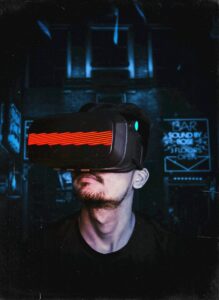

Does virtual reality harm your eyes, or is that just another myth? As it becomes more common in gaming, therapy, and entertainment, questions about its effect on eye health continue to grow. Before you give up your headset, let’s explore what science actually says about VR and your vision.
Bottom line: Enjoy VR safely by taking breaks, customizing settings, and listening to your body – most risks are temporary and preventable with good habits.
Stepping into virtual reality feels like entering a digital dream. In fact, the line between real and simulated fades, offering full immersion. Behind this experience is a powerful mix of hardware and software designed to transport you into vivid new worlds – whether you’re exploring serene landscapes or fast-paced action games.
As virtual reality becomes more popular, so do myths about its impact on eye health. Sensational headlines may warn of serious damage, but the truth is more balanced. Therefore, let’s clear up the common misconceptions and explore what VR really does to your eyes.
Here’s a quick chart that separates VR myths from the facts:
| Myth | Reality |
|---|---|
| VR Causes Eye Damage | There’s no strong evidence linking VR to permanent eye damage. Some people may feel mild strain or dryness. |
| VR Leads to Eye Fatigue | Long sessions can cause strain and blurry vision, just like screen overuse. Frequent breaks help reduce symptoms. |
| VR Is Unsafe for Kids | The long-term effects for kids aren’t fully known. Therefore, limit and supervise their use, and follow manufacturer guidelines. |
| VR Causes Permanent Vision Problems | Studies do not support this. Healthy users have not shown lasting changes in vision from VR use. |
| VR Is Bad for People with Glasses | Most headsets fit over glasses. In fact, some even support prescription lens inserts for better clarity and comfort. |
| All VR Headsets Are the Same | Device quality varies. Higher-end headsets offer smoother visuals, which can reduce eye fatigue. |
| Motion Sickness Is Inevitable in VR | Not everyone gets motion sick. It depends on the person, the headset, and the game design. |
Virtual reality is exciting, but it’s important to protect your eyes while using it. In fact, with a few simple habits, you can enjoy immersive experiences without strain or discomfort. Here are some tips to help keep your vision healthy during virtual reality sessions:

For example, avoid long, non-stop VR sessions. Use a timer and take a 5–10 minute break every 20 to 30 minutes. This helps prevent eye fatigue and lets your vision reset.
In addition, customize your VR headset to match your eyes. Set the interpupillary distance (IPD) correctly, and tweak brightness and contrast to reduce glare and strain.
Good posture reduces tension in your neck and shoulders. Adjust the headset for a secure, comfortable fit, and sit in a supportive chair whenever possible.
Dry eyes are common with screen use. Drink water regularly, and blink often while using virtual reality. Additionally, you may want to read our Hydrate Your Eyes blog post.
Even though VR is fun, don’t overdo it. Also, mix in real-world activities to give your eyes and brain time to rest.
Watch for signs of trouble like eye redness, blurry vision, or headaches. In addition, if symptoms don’t go away after rest, stop use and talk to an eye care provider.
Make sure to visit the Gunnar Optiks store for stylish gaming and computer glasses!
Curious about how virtual reality affects your eyes? Here are answers to common questions to help you stay informed and safe.
Not necessarily. Long virtual reality sessions can cause temporary issues like eye strain or fatigue, but there’s no proof that virtual reality harms healthy eyes long-term.
There’s limited research on virtual reality and children’s eye health. Therefore, to be safe, parents should supervise use, follow age guidelines, and limit time in VR to avoid overuse or discomfort.
Take breaks, adjust your headset for comfort, and sit with good posture. Also, stay hydrated and watch for symptoms like dryness, blurry vision, or headaches. If these issues persist, it could signal a deeper concern. Be sure to learn more about diabetic eye disease and related vision symptoms.
Researchers are still studying this. So far, no major long-term risks have been found. Using virtual reality responsibly and listening to your body can help avoid problems.
Some researchers are testing VR for vision therapy and rehab. While results are promising, more studies are needed before it’s widely used for treatment.

Virtual reality is transforming how we play, learn, and relax. But like any screen-based technology, it requires smart habits – especially when it comes to your eyes.
Despite dramatic headlines, VR is not a direct path to vision problems. Most users can enjoy it safely with just a few precautions. Take breaks, fine-tune your display settings, and watch for signs of eye strain or discomfort.
Be sure to check out the Gunnar Optiks store for a full line of stylish gaming and computer glasses!
The key is balance. Use virtual reality in moderation, stay mindful of how your eyes feel, and prioritize healthy screen habits. That way, you can explore digital worlds while protecting your real-world vision.
As virtual reality evolves, so will our understanding of how it affects our health. Stay informed, practice good habits, and enjoy the journey – eyes first.